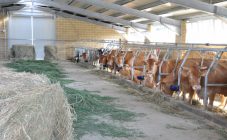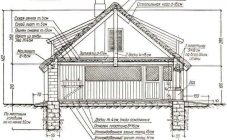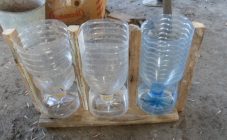Content:
Recently, more and more people are breeding chickens at their summer cottage. Even a small number of heads, about ten females, can provide a small seven, eight or nine eggs per day. In summer, layers can be carried under any conditions, but in winter they need to equip a special warm room. To build a chicken coop with your own hands for 10 winter chickens is an easy task, even a beginner can handle it.
Caring for chickens in winter
The chicken coop is where chickens spend their time during the winter. Considering that egg production depends on comfortable living conditions, you need to equip it correctly. If chickens are cold, they waste a lot of energy to keep warm.
In the chicken coop, it is necessary to create optimal conditions:
- Stabilize the thermal regime, which should be in the range from twelve to eighteen degrees. If the temperature is drastically reduced, then egg production, accordingly, falls. In the southern regions, chickens are able to withstand winter cold without additional heating. In the northern ones, it is imperative to install special heating lamps.
- Lighting in the chicken coop should be at least fourteen hours. In winter, daylight hours are significantly reduced, so it must be extended piece by piece. For this, fluorescent lamps are used.
- Indoor humidity must be kept between sixty and eighty percent. This is only possible if ventilation is arranged in the chicken coop. Especially if it has special valves. It is necessary to ensure that there is always fresh air in the house, but in no case should drafts be allowed.
- It is imperative to take care of the safety of birds from all sorts of rodents and predators that feast on chicken.
- It is important where exactly the premises will be located on the site. The place must be quiet, where nothing will disturb the birds.
All walls of the coop should be inspected for crevices or other openings through which cold wind can pass. Windows for the winter also need to be closed tightly and firmly. Lamps that serve as a heater for chickens must be installed in such a way that the chickens cannot burn themselves and at the same time do not break them. If there are frequent power outages in the village, then in this case you need to purchase a generator. Thanks to him, laying hens will be in a warm and comfortable room throughout the winter.
When preparing a summer chicken coop for wintering, you need to take care of indoor hygiene. To do this, you need to putty and disinfect the walls of the house. Then whitewash them and change the litter in the nests.
Winter warm do-it-yourself chicken coop for 10 chickens
It is very important to choose the right place where the chicken coop will be located:
- The poultry house is located in a place from where the smell of chicken manure cannot be brought into the house.
- Chickens should be comfortable indoors, no one and nothing should scare them, since this factor affects their egg production.
- It is best to place the chicken coop in the farthest corner of the site.
- The location of the premises must be chosen in such a way that it is possible to build an aviary as a continuation of the structure. Thus, the chicken coop and the aviary are a separate territory.
- To avoid flooding the chicken coop in the spring, you need to locate it in an elevated area where water does not accumulate.
- In order for a large amount of sunlight to enter the chicken coop, it is recommended to put its windows to the south.
- It is best to build a house close to the fence, a maximum of four meters, so it will be protected from the cold wind.
After the place has been chosen, it is necessary to prepare the site itself. To do this, you need to calculate the required dimensions. To accommodate ten chickens, the most optimal will be a chicken coop with parameters 100X200X150 centimeters. Thus, the area inside the premises will be fifteen square meters.
After the calculations have been made, the site is being prepared for the foundation. To do this, remove the top layer of soil, thirty, thirty-five centimeters high. This is done to prevent grass from growing near the building. Instead of soil, the site is covered with gravel, a ball of ten centimeters.
Then you need to create a detailed drawing, according to which the farmer will see how the poultry house will look like in the end result, what material is needed for construction and its amount. Thus, a budget for construction costs will be established.
It is important to make a drawing of both the inner and outer sides of the structure. There are many ready-made drawings, but it is best to create your own unique version that will best meet the owner's needs in terms of comfort for birds.
The best material for building a chicken coop would be oriented strand board (OSB), since it has a number of advantages:
- low cost;
- ease of use.
If the farm has a brick, then it is also suitable for building a poultry house. This will make the brick house much stronger and more stable. You can also use expanded clay concrete blocks. The choice of material in most cases depends on the budget and the capabilities of the owner. The most inexpensive option is still wood.
In addition, to build a chicken coop for 10 chickens, you will also need the following materials:
- sand;
- cement;
- nails;
- self-tapping screws;
- boards;
- bars;
- insulation material;
- roofing material;
- slate;
- electric cable;
- switch;
- light bulbs;
- glass or glass blocks;
- door hinges;
- Rabitz;
- expanded clay for floor insulation;
- pipe for organizing ventilation.
Step-by-step instruction
A phased construction plan consists of the following steps:
- First you need to build a foundation for the poultry house. It is recommended to stay on the choice of a columnar or pile option, because, thanks to it, additional ventilation of the floor covering will be created, so that the wood will not rot. Also, in the event of a flood, water will not enter the room. In addition, since the chicken house is very lightweight, such a foundation will be much cheaper and does not require a large amount of materials, while it can stand for a long time.
- After the foundation is ready, it will be possible to proceed with further work. The second stage will be the construction of the flooring. A support frame is made of beams and sheathed with boards at the bottom. Then, at a distance of half a meter from each other, logs are installed, the parameters of which are 100X150 cm. Then the base must be fixed on the pillars, on which the roofing material is first put.
- Then expanded clay is poured into the voids between the logs and boards are already laid on top of it. To prevent pests from entering the chicken coop, you can fill the floor with concrete.
- Then you can start directly with the construction.If the bars are chosen as the material, then they are placed one on top of the other, but between them it is imperative to put linen-jute material. Thanks to him, the cracks will be closed. If an OSB plate is used, then it is imperative to make a frame of beams, which is sheathed from the outside with a plate, then mineral wool is put, then the sheathing is made again. Thus, the walls will be a reliable shelter for birds from frost.
- On the south side, a ventilation pipe is inserted into the wall, but a damper must be installed in it. Windows and doors are also made. At the same time, hinges must be installed in the window frames so that the room can be ventilated. Doors are made of beams and sheathed with slabs.
- The roof can be made both single-pitched and gable, with a small attic. The beams need to be attached to the structure piping. Then flooring is made on the beams and after that the beams are first covered with roofing material, and then with roofing material.
Insulation of the poultry house
To maintain a positive temperature in the chicken coop, it must be additionally insulated.
To do this, you can use:
- mineral wool,
- Styrofoam,
- expanded polystyrene.
The insulation can be fixed both outside and inside the room. It is attached directly to the wall using a metal mesh. In case of internal insulation, it is necessary to cover a layer of insulation with plywood. Otherwise, the chickens will chew on the foam, and this will negatively affect their health.
Expert advice
Experienced experts recommend the device of a chicken coop inside for 10 chickens should be done according to the following rules:
- Additional insulation needs to be done on the floor. For this, peat, sawdust or straw are laid, with a ball of ten centimeters.
- Poles are made on which the hens will spend the night. The distance between them must be at least thirty centimeters. The length of the poles must be at least two meters. For each you need to install a ladder. Thus, it will be convenient for the hens to climb for the night.
- Nests are installed at a height of sixty centimeters from the floor. You can make them yourself from scrap materials. The bottom is lined with straw or sawdust.
- Bird feeders need to be made elongated. Thus, all hens can eat at the same time. Drinking bowls are arranged in such a way that water does not splash out of them while drinking.
- To extend the daylight hours, lighting is installed. The wiring must be mounted outside, while it is hidden in special boxes. Metal lampshades are put on the lamps.
Making a house on your own will be much cheaper than buying a ready-made house. In this case, all the arrangement is done to the taste of the owner. The project is planned in such a way that it fits favorably into the interior of the cottage. Even a novice poultry farmer can do all the work.
















You yourself read that you are writing it is interesting what kind of boards are such 100 cm by 150 cm I wonder how it was calculated the size of a chicken coop of 15 square meters indicating such parameters.